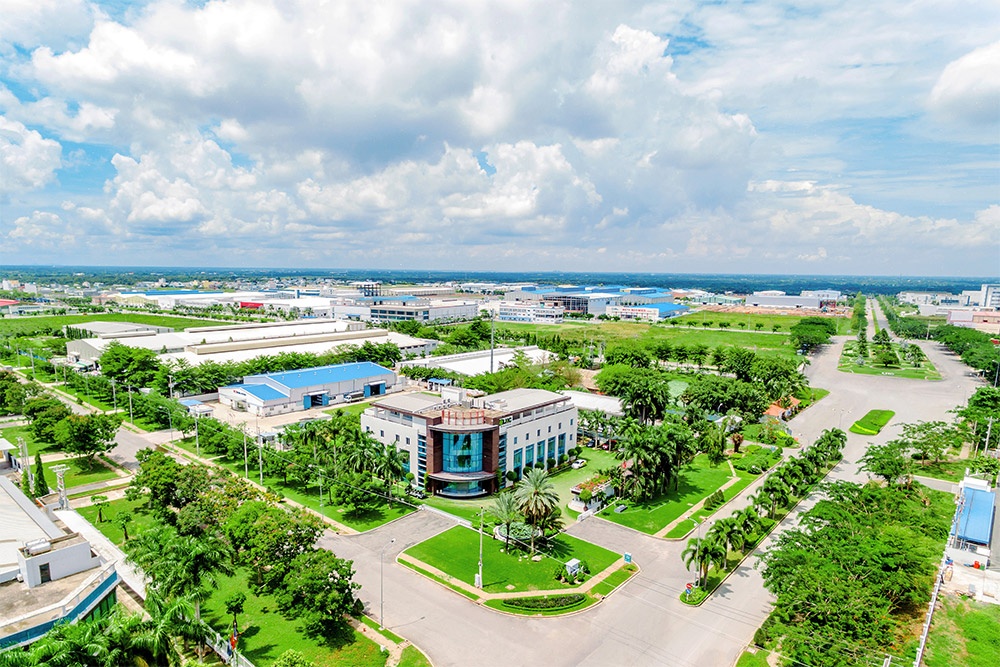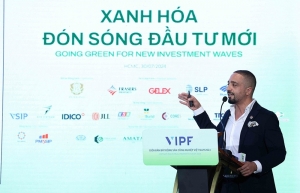Best results will come from eco-IP direction
 |
| By 2030, Vietnam could boast nearly 600 industrial parks, photo Le Toan |
According to Tran Thien Long, standing vice president of the Vietnam Industrial Real Estate Association (VARS), operating costs and rents in green industrial parks (eco-IPs) will be higher than normal IPs. However, it is necessary to consider the higher benefits for all sides, from developers and investors to tenants in the ecosystem.
“If an enterprise invests and commits to green transformation, it will certainly entice potential and valuable investors who will come to their IPs,” Long told VIR.
The most concerning current issue for IP development enterprises, according to Long, is not the issue of higher costs compared to previous investments, but how to make IP investors and enterprises renting warehouses and factories commit to effectively implementing a green transformation.
“IPs developers need to have specific commitments with sub-investors and tenants to jointly implement this transformation, then the value of the entire ecosystem will increase greatly. The image of IPs and manufacturers will also be much better according to investors and partners, so all parties will benefit,” he said.
Do Ngoc Diep, Vietnam green and resilient building programme lead for the International Finance Corporation (IFC), said that businesses and IPs with green transformation are having to pay high initial costs, but after only 2-3 years, they can recover the initial investment.
“If investors are having difficulty raising capital domestically, they can absolutely look to foreign green capital,” she said.
However, Tran Anh Dong, director of CAS-Energy, told VIR that it is currently very difficult for businesses to access green finance to transform. Furthermore, they also lack human resources to do so.
“We talk about green finance a lot, but activities have not done much, it’s almost Vietnamese businesses can’t access green finance both domestically and internationally,” Dong said.
For businesses which hope to be able to access financial resources from foreign funds, everything must be transparent, having clear business plans, high profits, and must have a reasonable and effective green transformation roadmap.
“The solution here is that although being supported by the government, the private sectors themselves must be more dynamic to be able to access this source of capital, there is a lot of green financial capital in the international market,” Dong added.
“This is also a double challenge for businesses when they have to fully implement stable production and business activities, implementing a greener transformation, and looking for capital to transform. This task is not easy when we have to do it all at the same time,” Dong said.
In addition, according to Long from the VARS, implementing the legal system related to eco-transformation in IPs will involve many ministries and branches, so there needs to be a “sector commander” to provide comprehensive direction for all sectors resolve bottlenecks promptly and reasonably, and support businesses on their transformation roadmap.
“This ‘sector commander’ will help Vietnam implement such a transformation systematically, avoiding overlaps that cause additional difficulties for businesses. The law is a solid legal basis for businesses to implement and support investors in the best way,” he said.
Research data from the VARS shows that, as of May 2024, the country has 425 IPs (including 4 export processing zones) established in 61 provinces, in a total natural land area of about 130,000 hectares.
IPs and economic zones have attracted over 10,400 domestic projects and over 11,200 valid foreign-led projects, with total registered investment capital of approximately $100 billion and $231 billion, respectively.
According to the Ministry of Planning and Investment, by 2030 the country will have about 575 IPs with a total natural land area of about 211,000ha.
One of the most vulnerable countries to climate change, the Vietnamese economy is already being impacted by an estimated loss equal to about 3.2 per cent of GDP in 2020, which is expected to escalate rapidly. While millions of Vietnamese rely on the ocean for a livelihood, the country’s blue economy is projected to contribute about 10 per cent to the GDP by 2030.
To achieve net-zero by 2050, Vietnam needs additional investments of about 6.8 per cent of GDP per year, or a cumulative $368 billion through 2040, half of which is expected to come from the private sector.
| Can Van Luc , member, National Financial Monetary Policy Advisory Council Green credit for industrial property is still blocked somewhere and has not been able to reach borrowers. This is due to mainly three reasons: first, domestic credit institutions have not yet designed appropriate green products, but are mainly based on the purpose of capital use and industry according to the guidance of the State Bank of Vietnam. Second, although there are some regulations on green bonds, regulations on green classification and certification of projects to be issued such bonds have not yet been released. Third, the cost of investing in green projects is often high, so project evaluation and appraisal also pose a big problem for both businesses and banks. Besides that, market awareness of green and sustainable bonds is still uneven. Some businesses have understood correctly, but there are also businesses that have a rudimentary understanding, so they are not drastic in finding capital. Although green finance has been deployed in Vietnam for more than 10 years, the scale is still small. Green credit only accounts for around 4.5 per cent of total outstanding debt, and green bonds are very few. In particular, the implementation of green credit still has many problems such as not enough legal framework, overall policies (including taxes, fees, and preferential capital) related to the implementation of green finance and sustainable finance. Green projects often have long terms of up to 20 years and large investment costs, while the sources of loan capital from credit institutions are often short- and medium-term mobilised capital, and the borrower usually requires preferential interest rates. From that reality, to develop green finance, Vietnam needs a comprehensive strategy to develop the green finance market in a harmonious and effective manner between capital channels, associated with the orientations of socioeconomic development goals. Tran Thanh Vu, director, Industrial and Civil Sector Consultancy, Edeec Green building development and industrial construction can both avoids added costs and significantly reduce investment and operational expenses. About 15-20 years ago, green buildings followed a traditional design process with green features added later, which resulted in increased costs. However, if those elements are integrated from the start, these costs can be greatly minimised Over the past 15 years, Vietnam has had about 300 projects with green certification, a number far too low given the market size. Developers need to return to the basics by planning green buildings from the outset, with support from expert consultants. Technical consulting plays a crucial role in optimising costs, including structural strategies that ensure efficient energy use and effective funding in a building’s technical systems. Many investors and developers often focus solely on achieving attractive renderings, standard construction drawings, and green certifications. However, they frequently overlook the core objective of such projects – maximising building operational efficiency, optimising costs, and adhering to sustainable, environmentally friendly practices. These are essential checklists that must be completed before moving to construction drawings or obtaining certification. Hardy Diec, COO, KCN Vietnam Vietnam is experiencing a significant shift towards green industrial real estate, driven by growing environmental awareness, government incentives, and increasing demand from international investors. The eco-IP model is definitely gaining significant traction in Vietnam as a sustainable and efficient approach to industrial development. Additional trends gaining momentum among developers in this country include sustainability certification, where there’s a notable rise in industrial projects seeking green building certifications like LEED or local Vietnamese standards like LOTUS. These certifications not only validate environmental performance but also enhance the project’s marketability and appeal to tenants. In renewable energy integration, industrial zones are incorporating renewable energy sources like solar and wind power to reduce their carbon footprint and operational costs. This aligns with Vietnam’s broader commitment to renewable energy adoption. Developers, meanwhile, are increasingly adopting circular economy principles, emphasising waste reduction, resource recycling, and the use of sustainable materials. This approach not only minimises environmental impact but can also create new economic opportunities. The integration of smart technologies, such as Internet of Things sensors and data analytics, is optimising energy management, water usage, and waste disposal within industrial parks, leading to significant resource savings. In green infrastructure, the focus is on creating green spaces, implementing rainwater harvesting systems, and using permeable pavements to improve water management, reduce heat island effects, and enhance the overall environmental quality of industrial zones. |
 | Green trends at the fore in industrial real estate sector Green transformation refers to a shift towards a more sustainable future in the industrial sector. The transformation of industrial parks (IPs) into sustainable green ones is achieved by promoting green production, the efficient use of resources, and the exchange of energy and by-products among enterprises within the parks. |
 | Lifting legal barriers for eco-industrial parks to thrive The set of standards to measure factors related to sustainable development and social impact of businesses is a global trend and has become a well-known concept among the businesses, especially when sustainable development continues to receive heightened attention. |
 | Green i-Park honoured for its green transformation strategies Green i-Park, the investor of Lien Ha Thai Industrial Park (Green iP1), has been praised for its green transformation strategies at the Vietnam Industrial Property Forum's special awards event. |
What the stars mean:
★ Poor ★ ★ Promising ★★★ Good ★★★★ Very good ★★★★★ Exceptional
Related Contents
Latest News
More News
- Sun Group breaks ground on $2 billion Van Don casino complex (December 19, 2025 | 18:14)
- Rare, beautiful, sustainable: the mark of iconic real estate (December 19, 2025 | 08:00)
- Owner-occupied housing stabilises, paving the way for new growth cycle (December 18, 2025 | 17:04)
- Unlocking urban potential of smart cities (December 18, 2025 | 16:50)
- Green finance offers 'passport' for Vietnamese construction, building materials firms (December 15, 2025 | 08:00)
- Gamuda Land commit long-term investment (December 12, 2025 | 11:49)
- HITC ties up with Evolution to develop AI and hyperscale data centres in Vietnam (December 11, 2025 | 12:09)
- Real estate deals boom via high-profile names (December 08, 2025 | 11:32)
- Industrial segment shaped by M&As (December 08, 2025 | 08:00)
- The Privé sets the benchmark for luxury real estate (December 05, 2025 | 08:28)

 Tag:
Tag:





















 Mobile Version
Mobile Version